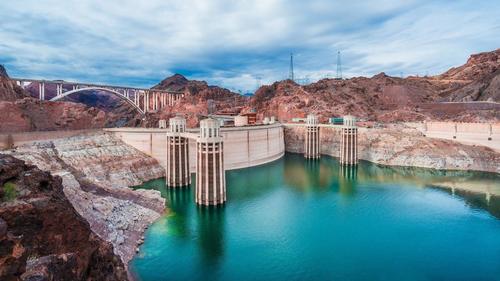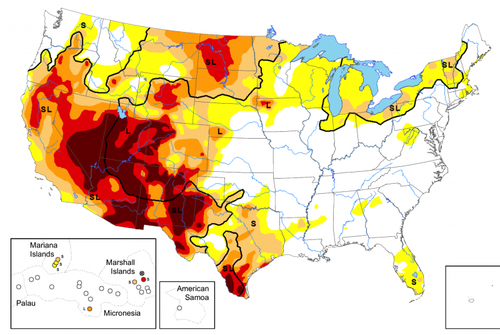Western US States Prepare For 1st-Ever Water Shortage Declaration; Hoover Dam Hydroelectric Generation At Risk
As the man-made lakes which store water for millions of people in the western United States are projected to shrink to historic lows in the coming months, state officials prepare for what could trigger the first-ever federally declared water shortage, which would prompt cutbacks in water usage in Arizona and Nevada.

According to the Associated Press, the US Bureau of Reclamation’s 24-month projections released this week forecast that less water will flow from the Rocky Mountains through Lake Powell and Lake Mead, and into the Southwest desert regions to the Gulf of California. The two lakes are expected to suffer from water shortages that could threaten the supply of the Colorado River which farms and sprawling cities rely on.
Lake Mead is projected to fall below 1,075 feet for the first time in June 2021, the level which will trigger the shortage declaration under agreements negotiated by seven states which are reliant on Colorado River water; Arizona, California, Colorado, Nevada, New Mexico, Utah and Wyoming.
That said, the April projections won’t have any material affect unless conditions fail to improve – in which case the Bureau of Reclamation will declare a Level 1 shortage condition, resulting in cuts that would take effect next January.
Arizona, Nevada and Mexico have voluntarily given up water under a drought contingency plan for the river signed in 2019. A shortage declaration would subject the two U.S. states to their first mandatory reductions. Both rely on the Colorado River more than any other water source, and Arizona stands to lose roughly one-third of its supply.
Water agency officials say they’re confident their preparation measures, including conservation and seeking out alternative sources, would allow them to withstand cuts if the drought lingers as expected. -AP
“The study, while significant, is not a surprise. It reflects the impacts of the dry and warm conditions across the Colorado River Basin this year, as well as the effects of a prolonged drought that has impacted the Colorado River water supply,” said Arizona officials from the state’s Department of Water Resources and the Central Arizona Project, in a joint statement.
In Nevada, special “straws” have been constructed to draw water from further down lake mead if levels fall – and the state has created a credit system where it can ‘bank’ recycled water back into the reservoir without having it count towards its allocation, according to the report.
Southern Nevada Water Authority director of water resources, Colby Pellegrino, told customers recently that those preparation measures would insulate them from any cuts – but warned that more action is needed.
“It is incumbent upon all users of the Colorado River to find ways to conserve,” she said in a statement.
At Lake Mead, water level are projected in the Bureau of Reclamation report to drop to the point where electricity generation at the Hoover Dam could be compromised – as the hydropower plant serves millions of customers in Arizona, California and Nevada.
To prepare for a future with less water, the bureau has spent 10 years replacing parts of five of the dam’s 17 turbines that rotate to generate power. Len Schilling, a dam manager with the bureau, said the addition of wide-head turbines allow the dam to operate more efficiently at lower water levels. He said the turbines will be able to generate power almost to a point called “deadpool,” when there won’t be enough water for the dam to function.
But Schilling noted that less water moving through Hoover Dam means less hydropower to go around.
“As the elevation declines at the lake, then our ability to produce power declines as well because we have less water pushing on the turbines,” he said. -AP
As Michael Snyder of TheMostImportantNews noted earlier this month; Scientists have begun using the term “megadrought” to describe the multi-year drought that has been plaguing the western half of the country, and now we are being told that it looks like 2021 will be the worst year of this “megadrought” so far by a wide margin. That is extremely troubling news, because major water reservoirs have already dropped to dangerously low levels, some farmers have been told that they will not be allowed to use any water at all this year, and the dust storms in the western U.S. are becoming so large that they can actually be seen from space. This is a major national crisis, and it is only going to get worse.
As you can see from the latest U.S. Drought Monitor map, nearly the entire western half of the nation is experiencing some level of drought at this moment.
But even more alarming is the fact that much of that territory is currently in one of the three most serious levels of drought…
A year ago, about 4% of the West was in a severe drought. Now, about 58% of the West is classified as being in a severe, extreme or exceptional drought.
As conditions just get drier and drier, many farmers have become deeply concerned about what that will mean for growing season in 2021.
New Mexico is right in the heart of “the second Dust Bowl”, and chile farmer Glen Duggins is bracing for a very difficult year…
The Rio Grande is expected to be in extreme drought this year, creating tough conditions for local farmers and putting New Mexico‘s beloved chile in danger. “It’s gonna be a tough year because we are out of water,” said Glen Duggins, a chile farmer out in Socorro County.
When he says that they are “out of water”, he is not exaggerating.
It is only early April, and the largest reservoir in the entire state “stands at less than 11% capacity”…
* * *
According to Lincoln County Power District General Manager Dave Luttrell, a combination of infrastructure updates, less hydropower from Hoover Dam and power generated from other sources such as natural gas has raised costs and alarmed customers in the rural Nevada district he represents.
“Rural economies in Arizona and Nevada live and die by the hydropower that is produced at Hoover Dam. It might not be a big deal to NV Energy,” said Luttrell of Nevada’s largest utility. “It might be a decimal point to Los Angeles Department of Water and Power. But for Lincoln County, it adds huge impact.”
Tyler Durden
Sun, 04/18/2021 – 11:40![]()
Zero Hedge’s mission is to widen the scope of financial, economic and political information available to the professional investing public, to skeptically examine and, where necessary, attack the flaccid institution that financial journalism has become, to liberate oppressed knowledge, to provide analysis uninhibited by political constraint and to facilitate information’s unending quest for freedom. Visit https://www.zerohedge.com

